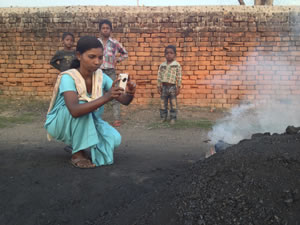Video Volunteers was set up in 2006 by Jessica Mayberry, an American, and Stalin K, an Indian, to empower the country’s most disenfranchised people to tell the stories the mainstream Indian media mostly ignore.
Only 2% of mainstream media coverage in India addresses the issues of rural areas, but they are where 70% of the population lives, Mayberry explained at a recent event in London. “These people are disenfranchised not just in society, but also in the media,” she said.
Video Volunteers, headquartered in Goa, has 212 “community correspondents” across 165 districts in India. In the last seven years they have produced more than 5,000 videos, of which 1,100 solved the problems the film addressed.
One, for example, covered a hazardous journey that children in a village in Uttar Pradesh had to make to get to school, which had led to the tragic deaths of two girls. After a community correspondent made a video about it, a school was built in the children’s village.
Another correspondent’s video about local people getting killed and injured by shooting on a firing range in Kashmir led to the lease of the firing range not being renewed.
Each film gives information about government programmes and has a call to action at the end, for example the phone number or address of a relevant government official.
The videos are professionally edited and then the correspondents screen them back in their local communities and use them to lobby the authorities.
The community correspondents include manual scavengers, auto rickshaw drivers, tribal people, farmers and housewives situated in locations where mainstream media often do not have reliable stringers (freelance correspondents). With no prior journalism experience, they are given 10 days’ training and a Flip camera or a tablet. The correspondents are paid stringer rates in their district for each story they produce, ranging from £40 to £100 per story.
“They all live below the poverty line, many cannot read or write, but anyone can learn to tell a powerful personal story,” Mayberry said.
Video Volunteers’ ambition is to have a correspondent in every district in India, a model Mayberry said could help democratise the media across the world, “as it empowers a large number of marginalised community members to regularly publish stories.”
Mainstream Indian TV channels have already started to develop stories from some of the videos.
Video Volunteers is now training people in rural areas to shoot and edit on smartphones. “This is a way we could scale up and have thousands of people contributing,” Mayberry says. “This is the future as more rural communities come online.”
Democracy and human rights are under threat in an India that is racing ahead towards progress at any cost, she says. “A lot of the middle class are sort of OK with the idea that [people living in poverty] are collateral damage.”
But she says people living in poverty in India are angry. “They are feeling the pain of this untethered development more than anyone else. That is why we are so focused on amplifying their voices.”
For more information, to donate and to watch the videos, go to https://www.videovolunteers.org







